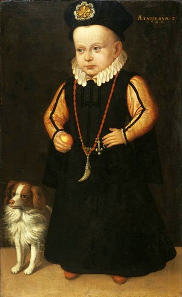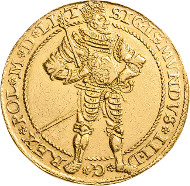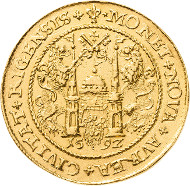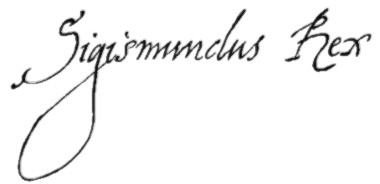On June 20, 1566, a baby was born in a prison cell at Gripsholm Castle. The name of the father was John Vasa. He was the younger brother of the Swedish king, and was to dethrone him only a few years later. The mother of the child was called Catherine, and she was the youngest daughter of Sigismund I, King of Poland.
The little Crown Prince Sigismund. By Johan Baptista van Uther. Source: Wikipedia.
Thus, it was a real political statement when the small child was baptized Sigismund, a very unusual name in Sweden, and was given a Catholic education in that Protestant country.
One has to bear in mind that Poland was an elective monarchy. The parliament not only exerted great influence on legislation but actually elected the ruler of Poland and Lithuania. At the time of his election, in 1587, Sigismund was no more than 21 years old.
King Sigismund III at the age of 25. By Martin Kober. Source: Wikipedia.
Within less than five years, in 1592, as the date when our coin was minted, his father, John III, King of Sweden, was dead and the young man would have loved to assume the second kingdom.
To do so, Sigismund needed to have the Polish parliament’s permission that he was entitled to announce his candidature in Sweden. This is where the gorgeous portugalöser comes in, which will be on sale at Auction 84 of Leipziger Münzhandlung und Auktion Heidrun Höhn e. K., on October 24, 2015. The specimen has a pre-sale estimate of 30,000,- euros.
Back in the 16th century, it was something of a royal custom to promote the loyalty of one’s subjects by presenting them with lavish gifts. High-ranking persons were given presentation pieces (‘schaustücke’ in German), such as this magnificent high-denomination gold coin. It was not the same as modern-day bribery, but rather a confirmation of the good relations by means of a generous gift.
Sigismund III Vasa 1587-1632. 10 ducats (portugaleser) 1592, Riga. Very fine-extremely fine. Estimate: 30,000 euros. This coin will be offered as lot 5239 at the Auction 84 of Leipziger Münzhandlung und Auktion Heidrun Höhn on October 24, 2015.
The obverse of the coin depicts Sigismund III as Polish King. He holds the clearly discernible Polish scepter and wears the crown of the Polish kings. The legend translates as: ‘Sigismund III, by the Grace of God King of Poland, Grand Duke of Lithuania’. The coin’s reverse refers to the city of Riga which belonged to the Polish-Lithuanian Commonwealth in those days. ‘The New Gold Coin of the City of Riga’ translates the inscription on the reverse. As another element of the depiction, we see the coat of arms of Riga: a city gate, held by two lions, with two crossed keys and a cross above. The lesser coat of arms, which divides the date 1592, shows the white knight, indicating that Riga did not mint in its own right but by royal order as part of the Grand Duchy of Lithuania.
Poland often issued high-denomination gold coins, such as this one. They were called portugalöser, hinting at the coins they were modelled on. These coins came from Portugal and were popular throughout Europe. They differed from local everyday change in that their intrinsic value roughly corresponded to their nominal value. Because of that, they could circulate everywhere. Furthermore, their value remained constant even in times of demonetarization, which made them suitable for saving.
Though the coin illustrated here is extremely rare today, it seems safe to assume that a considerable number of specimens were struck in 1592. An 1839 publication giving a description of a small variant of our die serves as proof that it actually took two reverse dies in 1592 in order to produce the emission. Most specimens are likely to have been melted down at some point, because of their metal value. The authors, writing at 1839, appraised the specimen at 300 zloty. That made the coin the then most expensive coin in the Cracow Museum. It remains to be seen what the coin is going to obtain today.
Signature of Sigismund III as king (REX). Source: Wikipedia.
Not to forget, Sigismund III actually succeeded in becoming King of Sweden. He could only do so after having allowed the Swedes to make Protestantism the official religion of the empire.
If you are interested in the coin featured in this article, you can go directly to the Auction 84 of the Leipziger Münzhandlung here.
Of course, CoinsWeekly is also offering an auction preview of this sale.










